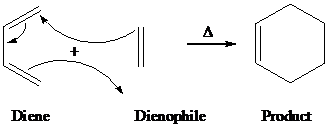
Concept explainers
Interpretation:
The reason why the given molecule, being a conjugated diene, cannot undergo the Diels–Alder reaction is to be explained.
Concept introduction:
舧 Diels–Alder is a type of organic reaction in which substituted
舧 The general reaction of Diels–Alder is as follows:

舧 The Diels–Alder reaction is between a conjugate diene and a reactant containing double bond (dienophile) to form a product, which is called adduct.
舧 The Diels–Alder reactions are highly stereospecific. The configuration of dienophile is retained in the product and the reaction is the syn addition.
舧 The dienes react with dienophiles in cis form rather than trans form.
舧 Endo and exo refers to the orientation of dienophile and its electron withdrawing group, when it reacts with a diene in Diels Alder reaction.
舧 The reaction with orientation of electron-withdrawing group of dienophiles under the
舧 The reaction with orientation of electron-withdrawing group of dienophiles away from the
舧 Endo is favored in the transition state of Diels Alder reaction because of its lower energy.
舧 If a compound is stable, it has lower energy and if a compound is unstable, it has higher energy.
Want to see the full answer?
Check out a sample textbook solution
Chapter 13 Solutions
Organic Chemistry
- Select the conjugated diene which cannot undergo the Diels-Alder reaction.arrow_forwardin a diels-alder reaction involving 2,3-dimethyl-1,3-butadiene and maleic anhydride, which is the diene and which is the dienophile?arrow_forwardWhich of the following conjugated dienes will not react with a dienophile in a Diels–Alder reaction?arrow_forward
- For each of the following products, draw the structures of the diene and dienophile necessary to synthesize the compound in a Diels-Alder reaction.arrow_forwardWhich diene could not participate in a Diels-Alder reaction?arrow_forwardDraw the structures of the diene and dienophile that would be used in the diels alder reaction to synthesize the following compounds. Label each structure as diene or dienophile.arrow_forward
- Draw a Diels-Alder reaction that shows the stereospecificity of the reaction with respect to both the diene and dienophile, and that would follow the endo rule (show only the major product).arrow_forwardImagine that you used isoprene as diene – in that case you don’t have to worry about assigning endo vs exo. Draw the "endo" and "exo" products of the Diels-Alder reaction between isoprene and maleic anhydride, and explain why the distinction is irrelevant here.arrow_forwardWhich compound from the list below can undergo a Diels-Alder reaction?arrow_forward
